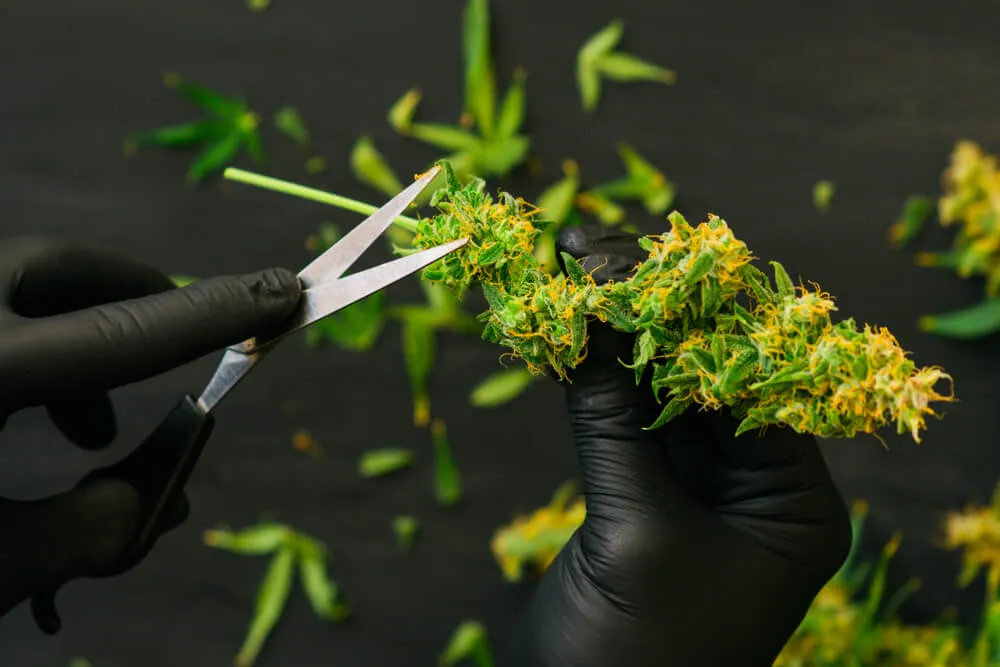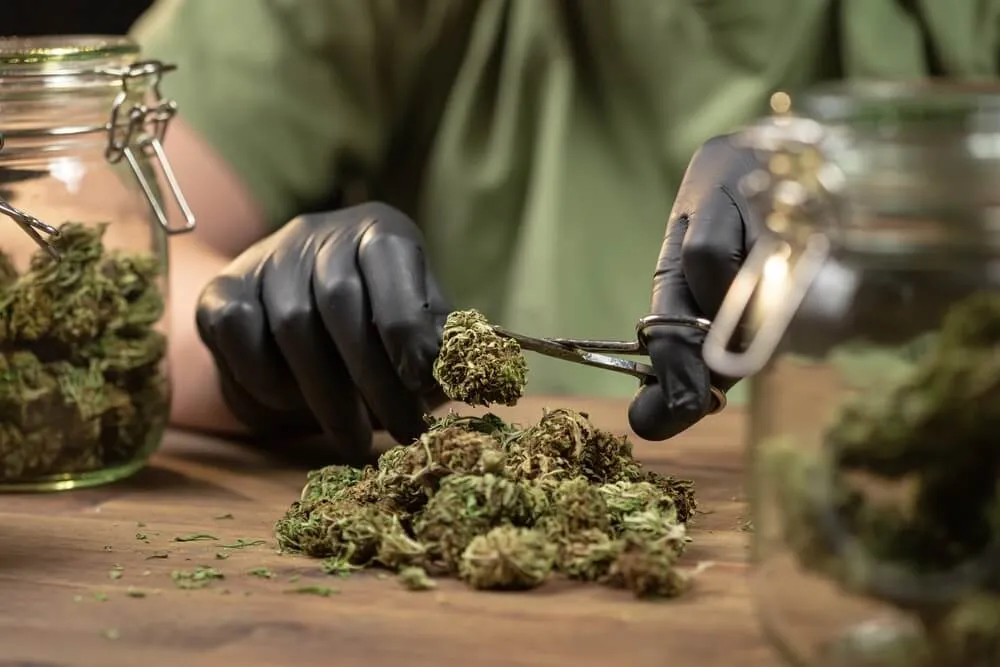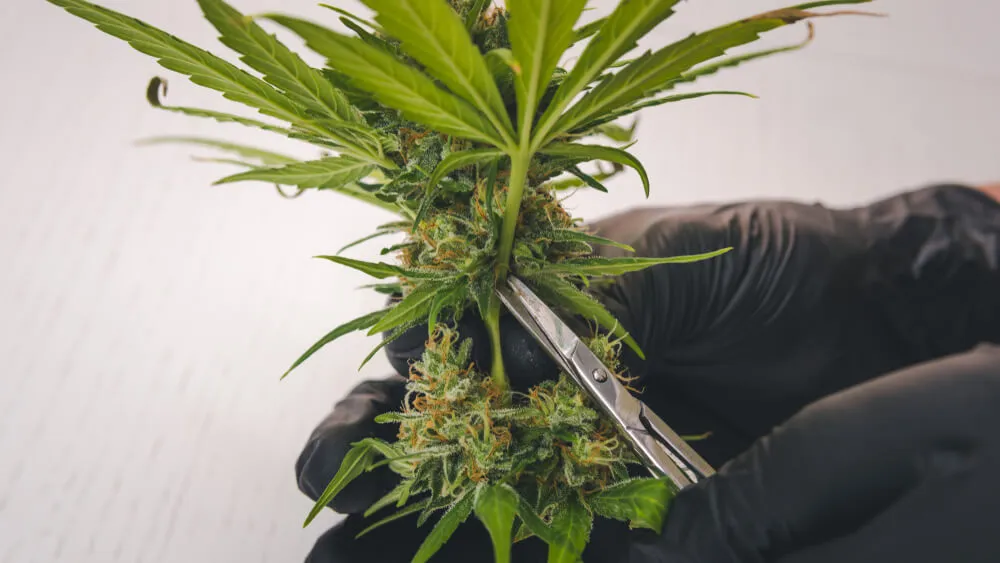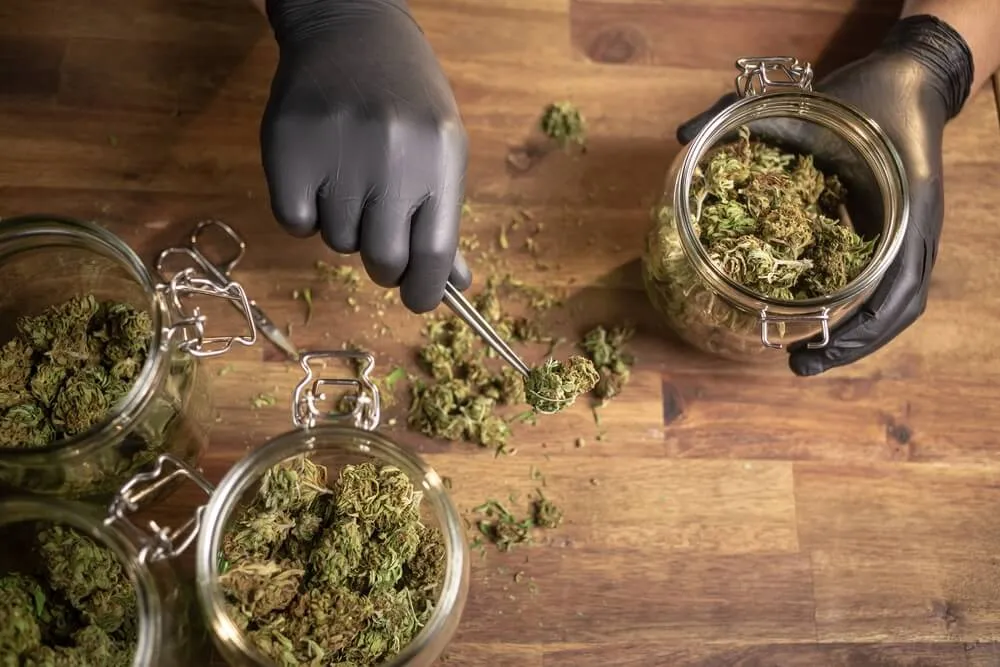Trimming Weed - The Ultimate Guide

The flowering stage is now finally complete and your cannabis plants are packed full with trichome rich bud just waiting to be smoked. Hold on though, the hard work isn't done just yet. Trimming is a critical stage of the overall process, and while it can seem a little daunting for beginners (and does require a bit of patience), it's actually a pretty easy task. In this guide, we'll show you everything you need to know about trimming weed, from the different methods you can use to the best tools for the job.
Any experienced weed producer will tell you that growing the plants is really only half the job.
Sure, the actual cultivation requires at least some dedication and expertise, but to get the final product that we all hope for - those stanky, sticky, delicious nugs that could win a cannabis cup - a little extra care is needed during the trimming process. Trimming weed is both an art and a science, so let's take a deep dive into everything you need to know before you start trimming your buds.
Why trimming cannabis buds is important
Before we go any further, let's have a quick look at the difference between trimming or manicuring your buds and cannabis defoliation.
Trimming weed is the process of removing unwanted plant material such as larger shade leaves and stems from around the buds, after you have harvested your crop. This is very important, as the leaves contain a much higher concentration of chlorophyll than the flower. While chlorophyll is vital in plant growth, it greatly increases the harshness of the smoke. Trimming your buds will make for a much smoother, more pleasant smoking experience, and will allow the terpene profile to really shine.
Manicuring is a similar process, but it generally refers to the removal of small leaves (usually referred to as sugar leaves - as they are covered in trichomes) that are growing throughout the budding sites. This step is not always necessary, but if you want your final product to look super pretty (like those perfect nugs you see in magazines), then it's worth taking the time to manicure your buds.
Cannabis defoliation is a technique that many growers use to increase yields, although it's generally not recommended for beginners. This involves removing fan leaves (and sometimes whole branches) from the plant while it is still growing, which can be done by hand or with specialized defoliation tools. This process will stress the plant, but if done correctly it can lead to bigger, denser buds. It can also help to reduce the risk of mold or pest issues.
When should you start trimming weed plants?
Removing fan leaves – Defoliaton
Defoliation comes in a range of styles. Most experienced growers like to remove leaves by hand by pinching the leaves where they attach to the branch and carefully twisting them free, but if you are just starting out then we suggest using a pair of sharp trimming scissors. If you are going to be doing heavy defoliation, then it's worth considering investing in some good quality defoliation scissors.
For timing, the general consensus is that you should do your first round of defoliation in the week before the plants switch from veg to flower, and then again when the crop is 3 weeks into the flowering cycle. For a full guide on how to properly defoliate your plants head right over here!
Actual trimming, not cutting for training or defoliation, should take place once the plant has been flushed and harvested.
Wet, dry, and machine trimming – What's the difference?
There are two main forms of trimming at harvest time - wet and dry. Which one you choose will depend on a few different factors, but the main things to consider are the equipment you have available, and your own personal preferences.
The jury is still firmly out on which method is best. Ask 100 experienced growers which method they prefer to use and there is a good chance that you'll get a pretty even 50/50 split. From our experience on farms in the USA, most commercial grows opt for dry trimming. For our own personal grow ops we usually use a combination of both methods, but we'll dive into the intricacies of both options in the next section.
Wet Trimming weed
Wet trimming is exactly what it sounds like - you trim your buds while they are still damp, typically directly after harvest. This can be done with or without the aid of gloves, but we would recommend using gloves if you have them, as wet buds can be extremely sticky. However, if you choose not to use gloves, make sure your hands are very clean. That way the inevitable build up or resin that sticks to your fingers can be collected and turned into excellent finger hash!

The main advantage of wet trimming is that it's much easier to remove the small leaves and sugar leaves, as they tend to shrivel up during the drying process making them more tricky to remove. This means that you can get a really nice, clean trim with less effort. Keep in mind that buds that have been wet-trimmed will dry faster. This can be a pro or con, depending on your ambient temp and humidity. If you live in an area with high humidity we suggest to wet trim, as this will reduce any chance of mold issues occurring during the drying time.
Buds that have been wet trimmed (at least to some degree) will usually puff out, increasing the bag appeal and aesthetics. It can also help with keeping the maximum amount of trichomes on your harvest, as the crystals become more fragile and easier to break once the drying process has finished.
Dry Trimming weed
Dry trimming involves removing only the large, unwanted fan leaves before the drying period takes place while leaving the rest of the plant intact. The plant can be broken down into branches, or be left whole. This can take anywhere from 7-12 days, depending on how you dry your cannabis and the drying room environment.
The main advantage of dry trimming is that you can take your time and really get a nice, clean trim, and it allows for extra control of the drying timing. Buds that take a little longer to dry will result in an overall better final product thanks to higher levels of cannabinoid production and a fuller terpene profile. Dry-trimmed cannabis provides a smoother, more pleasant smoke as the longer drying period allows for a higher rate of chlorophyll reduction.
While it can be a little thicker to trim the sugar leaves thanks to them shriveling, they do also "snap" off much easier than with wet trimming, so it's really all a bit of a trade-off and is definitely strain dependant.

Machine Trimming weed
Machine trimming is the quickest and most efficient way to trim your crop, but it does come at a cost - both financially and in terms of quality. There are many different types of machine trimmers on the market, but they all essentially do the same thing - they strip away all the leaves from your buds using spinning blades.
The biggest advantage of machine trimming is the speed. You can easily trim an entire crop in a day or two, whereas it would take weeks to do by hand. This is great if you are on a tight timeline or have a large number of plants to get through.
However, there are some big disadvantages to consider. Firstly, machine-trimmed buds will never look as good as hand-trimmed buds, as the blades tear and damage the delicate trichomes and leaves, resulting in a less-than-ideal final product. It is very easy to over-trim your buds with a machine, which can leave them looking quite bare. Machine trimmers are EXPENSIVE, with most good quality trimmers costing thousands of dollars. Unless you have a huge crop to get through and don't mind the quality of the final product being compromised we suggest staying clear of machines and trim by hand.
Tools needed to trim your bud
There are a few key pieces of kit that every trimmer should have at hand. First up is a pair of quality trimming-specific scissors. There are a couple of great options available, but our favorites are:
- VIVOSUN CURVED BLADES - Spring-loaded, with a soft rubber grip for long-lasting hand comfort.
- HYDROFARM TITANIUM PRECISION CURVED BLADE PRUNER - Very similar to the VIVOSUN, but with a slightly stronger spring and a higher price tag.
- CHIKAMASA STAINLESS STEEL SCISSORS - More like a regular pair of scissors than the spring-loaded options, but possibly the best option currently available on the market. These are the scissors we currently use, as the spring-loaded pairs make our hands cramp a little.
Are specific trimming scissors necessary? Hell yeah, they are. If you want a terrible trimming experience, then by all means grab that old, rusty pair of school scissors out of that random kitchen drawer. But if you want to save time, and have the best-looking final product then you should 100% buy a set of these.
Other than the scissors, you should grab:
- A dedicated trim tray. There are a bunch of options available, but we can't go past the OG Trim Bin. It's roomy, has a compartment to hold all your tools, and closes up nice and tight for easy storage. But, most importantly, it has a micron mesh filter on the bottom to allow only the trichomes to fall through, meaning you won't waste all that kief that falls off the buds during the trimming process.
- Isopropyl alcohol - This is absolutely necessary if you want a SATISFYING EXPERIENCE WHILE TRIMMING. There is nothing more annoying than trying to trim with scissors that are covered with super sticky trichomes. A quick dip into isopropyl and a wipe-down fixes this quick smart.
- Trim in a set of clothes you don't care about. No matter how careful you are, you're going to get covered in kief which is a bitch to clean off, even in a washing machine. If you suffer from hay fever then it's best to also wear a mask.
How to trim weed plants?
Wet trimming
For wet trimming, you are going to want to start as soon as you cut the plant down. Start by cutting the plant down to the branches, and then remove all the fan leaves. These can be discarded, as they have no trichomes on them. Some growers like to save these to use to make a cannabis tea, but we just throw them straight into our compost heap to be used as fertilizer for future organic grows.
Next up, start to carefully cut away the sugar leaves. DO NOT shave the buds, as that will result in you cutting away a lot of the bud formation. Instead, use the tips of scissors to get into the bud and snip away the sugar leaves from as close to the base as possible (you won't be able to see the base as it's hidden inside the buds).
Shaving buds is the number one crime against cannabis during the trimming process. If you are looking to work on a commercial farm as a trimmer then keep this in mind, as the trim room managers will instantly hate you for this mistake, and we have even seen trimmers kicked off farms for shaving flowers.
Once you have removed the sugar leaves it's time to hang the buds up to dry. It is easier to trim single buds that have been removed from the branches, but this will take up a lot more space if you are hanging the buds from the lines. Most people who wet trim leave the buds on the branch for this reason.

Dry trimming
For dry trimming, the process starts the same. You can remove all of the fan leaves as soon as you cut the plant down and then remove the branches from the main trunk - unless you live in a super dry climate. If this is the case, we recommend leaving the plants as a whole. This helps slow down the overall drying time. If the crop is taking too long to dry, you can start to remove the fan leaves and branches as you see fit. You want the drying period to take between 7 to 12 days, and remember to keep an eye out for any signs that mold is starting to develop if you are slowly drying.
Once the buds are dry, it's time to start trimming. The process is the same as stated above for wet trimming.
Here at MSNL, we like to use a combination of both methods, but really you should let your climate decide. If you live in a extremely dry area then leave the plant whole and let it slowly dry. If, on the other hand, you live in sub-tropics where the humidity can be hard to control, we suggest wet trimming. There's no one single answer as to what the best way to trim is, so experiment and find out what works best for you.
What can you do with the leftover weed trim?
There are a bunch of options for how to use your trim. Anything with trichomes can be salvaged and repurposed so the last thing you should do is throw it away! It can be used to make edibles, BHO, bubble hash, shatter, wax, or you can simply rub it over the micron mesh filter in your trim bin to extract the kief (although this last option is kinda wasteful).
What's next after you have trimmed your cannabis plant?
That depends if you wet or dry trimmed. If you wet trimmed then it's time to hand the branches or buds up to dry. If you dry trimmed, then it's time to grab your mason jars, seal them up, and store them in a cool, dark place - this is known as curing and is just as crucial as growing, drying, and trimming correctly if you want to end up with top-shelf mary jane. Drying cannabis itself is a vital part of the harvesting process worthy of its own article, click right here to read the full guide on drying your bud.

So there you have it, everything you need to know to trim your harvest. Let us know how you go in the comment section below, or join the community over at reddit/r/msnl and show us the end result. We would absolutely love to see it!
-
20+ Years Experience
Over 500K seeds sold worldwide
100K+ Happy Customers -
Germination Guaranteed
Complete satisfaction or we will replace your order -
Dutch and USA Genetics
Master breeders inspiring strains from across the world -
1-5 Day Delivery - Guaranteed
Free Express Shipping to the US, Canada and UK








